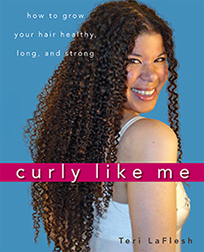
Available now!
Curly Like Me, the off-the-grid, do-it yourself owner's manual for tightly curly hair, is ready for ordering. Grab your copy today!

Every purchase made from
this site (through Amazon)
helps support it — and it
doesn't cost you anything
extra.
|
|
In the ingredient descriptions: Good means that I like to see this in a product's list of ingredients. Okay means this product appears safe for a curly person like me to use. Caution means that this ingredient may not be good in some hair care products, or for some people. Avoid means this ingredient may hurt your hair. If you see this ingredient in a hair product, it's best to put it down and walk away.
|
|
| |
Propylene glycol
(aka 1,2-Propanediol)
Okay
Humectant. This is a clear, colorless, thick liquid. Can penetrate the skin better than glycerin, but is less expensive. Second in moisture-carrying abilities only to water. Can also be used to dissolve ingredients (in the way that water can dissolve them). Winter pg 428. Rumors have circulated that it is bad, but there is no research validating this. For more information, check out Propylene Glycol Begoun pg 1326.
Source(s):
Begoun Winter
|
Propylene glycol dicaprate
Okay
Used as a conditioning ingredient. It works by preventing water loss. It's also used to thicken products. Made from Propylene glycol and capric acid [Gottschalck pg 1566].
Source(s):
Gottschalck
|
Propylene glycol dicaprylate
Okay
Used to condition. Works by preventing water loss. Made from Propylene glycol and caprylic acid [Gottschalck pg 1566].
See also:
Occlusive
Source(s):
Gottschalck
|
|
|
Propylene glycol oleate
Okay
Per Gottschalck (page 2285), this is used as a skin conditioner, emollient, and it helps keep un-mixable ingredients together (such as oils and water).
Source(s):
Gottschalck
|
Propylene glycol stearate
(aka Propylene glycol monostearate; PPG-1 stearyl ether)
Okay
Per Hunting (Conditioning) pg 347, propylene glycol stearate is used for conditioning and softening, but is sort of weak doing that. It also helps water-in-oil emulsions stay together - but only if there is a stronger product doing most of the keeping together. It's a white to cream-colored waxy solid that isn't water soluble.
Source(s):
Hunting
|
|
References:
Applewhite, Thomas H., ed. Proceedings of the World Conference on Lauric Oils: Sources, Processing, and Applications
AOCS Publishing, 1994.
Barel, André O., Marc Paye, and Howard I. Maibach., eds. Handbook of Cosmetic Science and Technology, Second Edition
Marcel Dekker, Inc., 2001.
Begoun, Paula. Don’t Go Shopping for Hair-Care Products Without Me. 3rd Edition.
Renton: Beginning Press, 2005.
Begoun, Paula. The Beauty Bible.
Renton: Beginning Press, 2002.
Begoun, Paula. Don’t Go to the Cosmetics Counter Without Me.
Renton: Beginning Press, 2003.
Bellum, Sarah, ed. The Beauty Brains: Real Scientists Answer Your Beauty Questions
New York: Brains Publishing, 2008.
Gottschalk, Tari E. and McEwen, Gerald N, Jr. PhD, eds. International Cosmetic Ingredient Dictionary and Handbook, Tenth Edition 2004, Volumes 1-4.
Washington D. C.: The Cosmetic, Toiletry, and Fragance Association, 2004.
Halal, John Hair Structure and Chemistry Simplified, Fifth Edition
Albany: Milady, 2002.
Hunting, Anthony L.L. Encyclopedia of Conditioning Rinse Ingredients.
Cranford, NJ: Micelle Press, Inc., 1987.
Hunting, Anthony L.L. Encyclopedia of Shampoo Ingredients.
Cranford, NJ: Micelle Press, Inc., 1983.
Johnson, Dale H. (Ed.). Hair and Hair Care, Cosmetic Science and Technology Series. Vol. 17.
New York: Marcel Dekker, 1997. Print.
Nnanna, Ifendu A. and Jiding Xia., eds. Protein-Based Surfactants: Synthesis: Physicochemical Properties, and Applications (Surfactant Science)
Madison Heights: CRC, 2001.
Quadflieg, Jutta Maria. Fundamental properties of Afro-American hair as related to their straightening/relaxing behaviour.
Diss. U of Rheinisch-Westfälischen Technischen Hochschule Aachen, 2003.
Schueller, Randy and Perry Romanowski, eds. Conditioning Agents for Hair and Skin.
New York: Marcel Dekker, Inc., 1999.
Winter, Ruth M.S. A Consumer's Dictionary of Cosmetic Ingredients: Complete Information About the Harmful and Desirable Ingredients Found in Cosmetics and Cosmeceuticals
New York: Three Rivers Press, 2005.
Zviak, Charles., ed. The Science of Hair Care (Dermatology)
New York: Marcel Dekker, Inc., 1986.
|
|